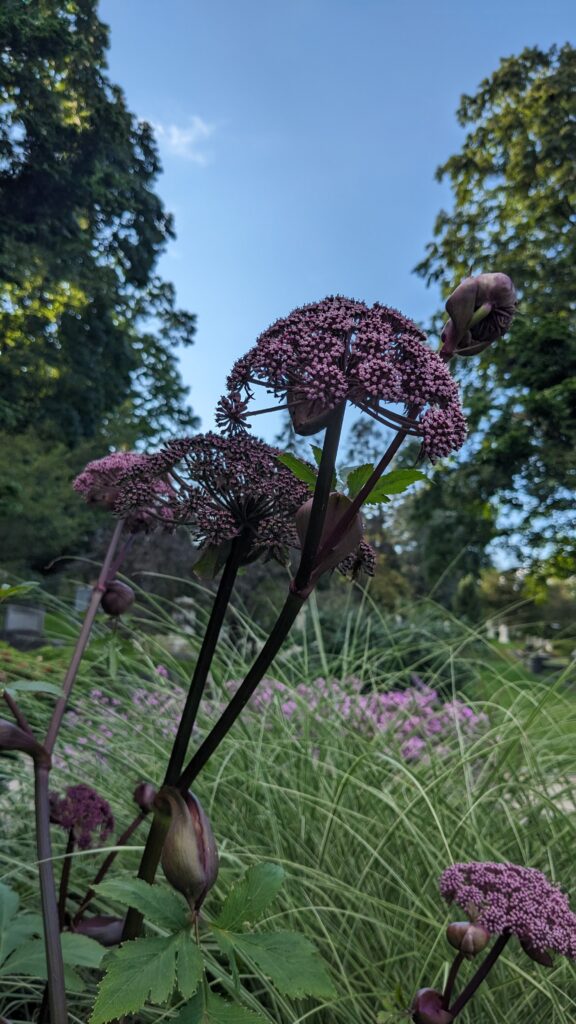Horticulture Highlight: Korean angelica, Angelica gigas

…The rest was done in grays, light and shadow
as they played along her dress, across her face,
and through her midnight hair, lively with bees…
-Eleanor Wilner
In September 1991, a mummified 5,300-year-old body was revealed by melting ice in the Italian Alps. Nicknamed “Otzi,” or “the Iceman,” he was preserved intact along with clothes, tools and miscellaneous carried artifacts. In addition to axe, knife, arrows, etc. he was found with a birch tree polypore (fungi), Fomitopsis betulina. It is postulated he was carrying this for its curative properties. Therein was an example from five-millennia ago of human herbal use of plants for healing. However, all fungi previously long believed to be in the plant kingdom, are now considered to be more like animals than plants.
Long traditions in worldwide herbal medicine have provided countless tens of millions with actual or perceived health benefits from plants. Ancient Sumerian, Egyptian, Chinese, and Indian cultures left archaeological evidence of herbal uses. Greeks Theophrastus’s Enquiry into Plants from about 300 BC, and Dioscorides’s De materia medica from AD 50-70 were great works in early printed botany that included herbal uses.
Subsequently botanists, often referred to as herbalists, did not publish in English until the 16th and 17th Centuries. Those books included drawings and paintings of plants accompanying descriptive text and uses. John Gerard (1545-1612) published one of the more renowned early examples, The Herbal or General History of Plants in 1597. Revised and enlarged by Thomas Johnson in 1633, it contained more than 1000 species and has adherents into our current time.
This month we focus on the genus Angelica, its etymology is from the Medieval Latin herba angelica, “angelic herb”. Purportedly the archangel Michael revealed this genus as a medicinal plant to a 14th Century monk in a dream. The Herbal exudes its divine reputation, “…The roots of garden Angelica is a singular remedy against poison, and against the plague, and all infections taken by evil and corrupt aire… It is reported that the root is available against witchcraft and inchantments, if a man carry the same about them…”.
Currently the genus includes about 90 species of perennials and biennials native across the temperate Northern Hemisphere. Today the roots and stalks of Angelica species still provide herbal/medicinal aid, but mostly in bronchial ailments, coughs, colds and digestive troubles. It is also highly prized in the liqueur production of chartreuse, specialist gin and English bitters.



One lesser known species is an aspiring garden star, the Korean angelica, Angelica gigas. New to many gardeners, this unusual plant rises to 6-7 feet-tall, standing out visually whether as a single specimen or within a plant-packed border bed. The bold verticality of its rigid stems are surmounted by dark purple compound floral umbels. These stems and flowers rise above lower clumps of large, deeply dissected, leaves. These ornamental eye-catching attributes are combined with its high-level attractiveness to bees, flies, wasps, beetles and other pollinators. Whatever the reason(s) there is a constant buzz of pollinators working the blossoms.
The pedigree of the honey does not concern the bee;
A clover, any time, to him is aristocracy.
-Emily Dickinson
In light of our chosen quotes from The Herbal herein, on a future visit to Mount Auburn enjoy the ornamental beauty of Korean angelica within our Asa Gray Garden, but please do not forage for any roots of these or other plants that comprise our remarkable living collection.
Leave a Reply